What to do in Tokyo? The 15 essentials

Every era has its story, but no story can last as long as in Tokyo . Between ancestral temples and modern skyscrapers, the capital of Japan is in perfect balance between past and future. But this balance is not only architectural, it is also in the myths. Make way for love and loyalty with the legendary dog Hachiko, or move into a world of revenge and honor with the 47 r ō nins . In this whirlwind of opposites, of contradictions, it is hard to find one's place and to know how to apprehend this new world. Because Tokyo alone can constitute a world. Huge city with a population of over 13 million, it is full of secrets. Because the Japanese metropolis is difficult to grasp. Lit or unlit, wide or veined with small streets, it only takes one turn to find yourself deprived of what you have acquired. Yes, you will get lost, but you will discover another world and who knows, maybe a part of yourself.
!Also discover the must-see places in Japan
1. Tsukiji Fish Market

It is the largest fish market in the world ! Every day, more than 50,000 people come to get their supplies. However, it took little for tourists to be banned from entering. Indeed, in 2008, the Tokyo town hall prohibited access to tourists, but it reconsidered its decision in 2009. Discretion is therefore essential to keep this place accessible to future foreigners! To fully enjoy the atmosphere of this place, you will have to come early and, of course, stroll between the stalls. You will attend the sale of fish at the auction, except for that of bluefin tuna which is prohibited to the public. Among this tide of shellfish hide several really delicious sushi bars! It's even an unmissable culinary stop in Tokyo ! One of the best addresses is Daiwadzushi which offers several options between ¥2,000 and ¥3,500. With its light blue-gray front, Rokumeiken is one of the least expensive and the sushi there is admirable! A word of advice: don’t wait until 12:30 p.m. to eat! Enjoy a walking tour of the Tsukiji outdoor market here!
Find the Tsukiji fish market in our ranking of the 10 colorful markets to discover in the world!
2. Senso-Ji Temple
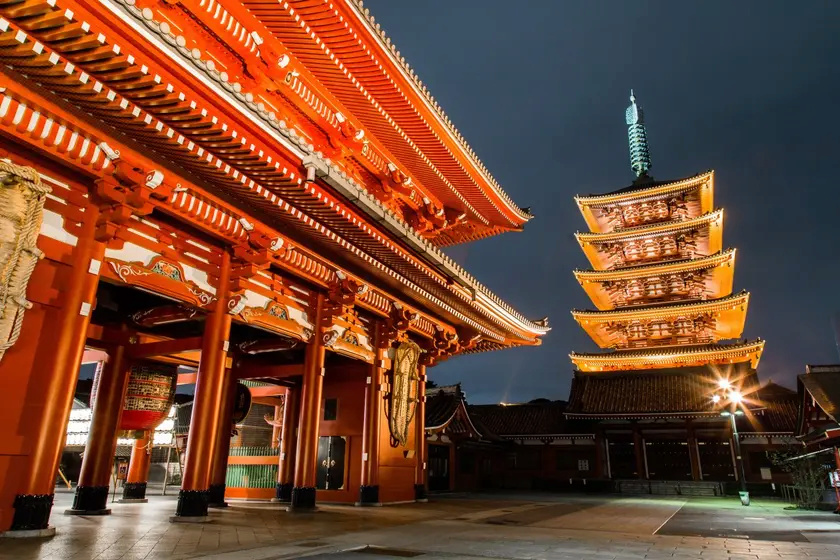
One of the oldest temples in Tokyo. Built in 628 by three fishermen, legend has it that they found in their net a golden statue of the divinity Kannon, the goddess of compassion. So, to protect this property, they would have created this building. Today, the statue of the goddess remains invisible to our eyes. Many events destroyed this place, but it was always rebuilt. The main entrance is to the south and is protected by two guardians, Fujin, god of wind, and Raijin, god of thunder. On your way, you will come across a huge red paper lantern, a place that tourists love for souvenir photos! As you walk, you will come across a gigantic leather censer. The smoke that emerges is used by the faithful to purify themselves and has many therapeutic properties.. Multiple buildings are located around this place, including a monastery, the Denb ō in, and a pagoda, the Gojunot ō . Explore Asakusa with a guide and discover the most popular sites at Senso-ji Temple !
3. The statue of Hachikô

This square near Shibuya Station has become a meeting place for Tokyo residents . It may seem quite ordinary at first glance, but the statue paying homage to Hachikô and his story will probably make you change your mind. This dog is probably one of the most famous in the world thanks to the American film Hatchi . Every day, Hachikô accompanied his master to Shibuya station and returned alone to pick him up at the same place. But one day, Hidesabur ōUeno, the master of Hachikô, dies following a hemorrhage during his work hours. Despite his death, Hachikô continued to go to the station day after day to wait for his return... This wait lasted almost 10 years, until Hachikô's death. This true story moved Japan so strongly that numerous tributes were created for Hachikô. Today a symbol of fidelity and loyalty in Japan, Hachikô is nicknamed Choken, the faithful dog. Part of his remains are buried near the tomb of his long-awaited master.
4. Sengaku-ji Temple

This temple was founded in 1612. It is famous thanks to the story of the 47 r ō nins and has been adapted many times for the screens. This historical fact, dating back to the year 1701, began with a katana blade taken out by Naganori Asano in the grounds of the palace of the sh ō gun. Which constitutes a serious mistake for the time. He was punished by being stripped of his status. He lost all his property, including his land. This resulted in the loss of 300 of his samurai. No longer having a leader, they became mercenaries. One of them decided to avenge his master and recruited 46 other samurai. They waited 2 years before taking revenge. After the beheading of the leader, they placed his head on the tomb of their master, Naganori Asano, located in the gardens of the Sengaku-Ji temple and committed suicide there. Only one escaped this disastrous fate, Kichiemon Terasaka, who was pardoned by the sh ō gun. Since then, every December 14, pilgrims come to decorate the tombs of the 47 r ō nins located in the temple with flowers..
5. The Imperial Palace

It was once one of the largest castles in the world. Today, it no longer has its former presence, but it can be a relaxing stopover! Located in the heart of Tokyo , it is a true green setting surrounded by concrete. You will only be able to enter on December 23, the birth date of the emperor, and January 2, the official day of the presentation of vows. However, you can observe the ramparts and bridges overlooking the moat, but also the Eastern Garden. Located near the Ote-mon gate and with an area of 21 ha, you can contemplate the foundations of past buildings, including the keep of the former shogunal palace.destroyed by fire. A stop at Ishibashi Bridge is necessary! It is one of the most seen tourist places in Japan! In spring, a stroll around the moat of the imperial palace is an opportunity to observe magnificent cherry trees in bloom. To add a romantic side to your getaway, you can rent a boat! Make your stay easier by opting for an audio-guided tour of the Tokyo Imperial Palace at a lower cost!
6. Shinjuku
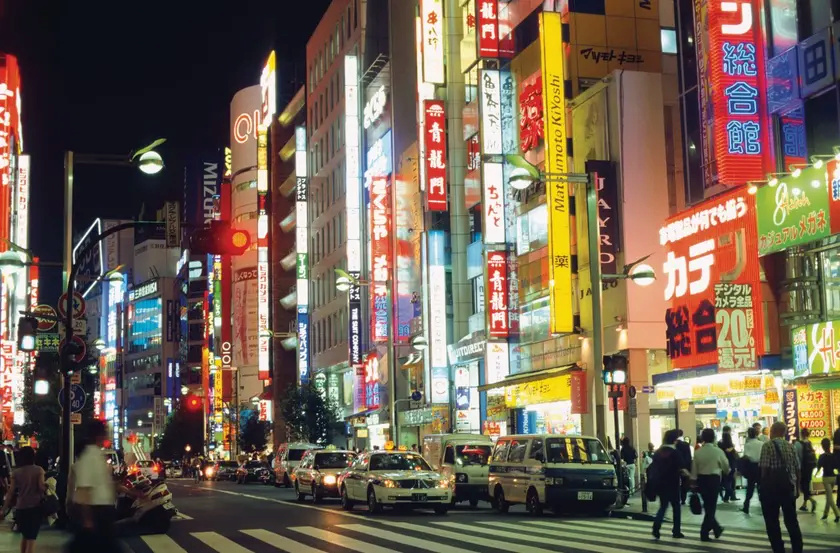
Shinjuku is one of the liveliest areas in Tokyo . Here, more than 107 different nationalities coexist! Most of the Japanese department stores are located there, but also the head offices of several international companies. At the very beginning of its history, this district was considered a suburb of Tokyo. But the Kant ō earthquake of 1923 paradoxically created an increase in interest in Shinjuku. In fact, this area is one of the least sensitive to earthquakes . Which justifies the large number of skyscrapers present in this district of the city Tokyo. The good plan will be to go to the headquarters of the Tokyo Metropolitan Governmentalso called Tokyo City Hall. Considered the largest town hall in the world; you can enjoy free access to the city observatory to enjoy a spectacular view of Tokyo! At night, you can circulate in Shinjuku as in broad daylight! Indeed, many gigantic illuminated signs illuminate the district! Take advantage of your stay in Shinjuku to discover Mount Fuji and Hakone with a guide!
7. Tokyo National Museum

Created in 1871 inside Ueno Park, it is the largest museum in Japan . Spanning more than 10 ha, it is full of treasures of inestimable value. It is made up of four large buildings: the Honkan, the Heiseikan, the T ō y ō kan and the H ō ry u ji Homotsu Kan. The latter houses the works of H ōryu-ji, a Buddhist temple considered to be the oldest wooden construction in the world. You will see impressive sculptures, masks and many objects there. Being incredibly large, you will need to allow a lot of time to properly visit this museum. If there was a choice to make in this vast space, it would be the Honkan building. Japanese art is magnificently well represented there. Indeed, it houses the world's largest collection of traditional Japanese art . The Tokyo National Museum also has artifacts from the four corners of Asia: Khmer sculptures, Indian miniatures and Korean Buddhist statues. A journey through the entire history of Asia in one place!
8. Meiji Jingu Shrine

This shrine is one of the most popular in Japan. Located in the heart of a gigantic park, each tree is a donation from a Japanese citizen in honor of the former Emperor Meiji . This marked its time because it pushed Japan to open up to the world. He also reformed the Japanese political system by creating an elected parliament and a constitution. Being a sanctuary, like any place of worship, certain customs must be respected, such as purifying one's body with water. You can get more information by clicking here. As you enter the park, you will cross a huge wooden torii , then you can stroll around the park and inspect the different structures: a museum, a music and dance hall, etc. You will also be offeredwaka , a genre of Japanese poetry, composed by the emperor and his wife. The surprise can be great at the sight of certain trees where wishes hang from their branches. Do the same! Maybe they will be granted!
9. Sumo tournament
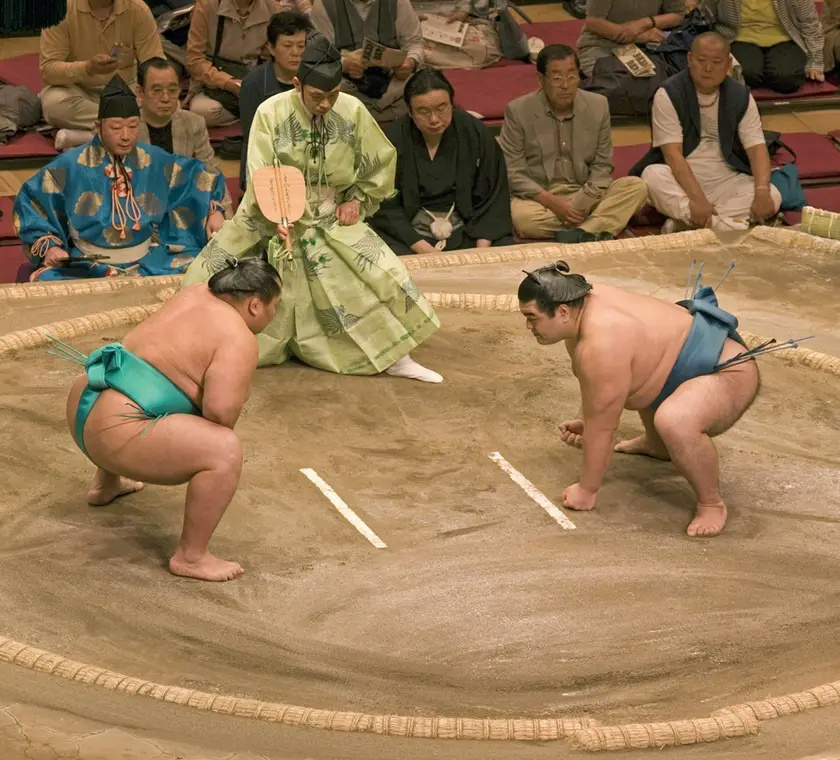
Literally translated, sumo means “to strike each other . ”This wrestling sport is typically Japanese and remains in our memories thanks to the atypical size of these wrestlers! Originally, these fights were dedicated to the gods. The aim was to promote good harvests. Today, this sport is no longer as popular, but it remains an unmissable event for anyone curious about Japanese culture! When purchasing your tickets, try to get the best seats which are located to the north and south. This way you will have the best view! Obviously, the price is more expensive... If you absolutely want to attend one of these duels without hurting your wallet, arm yourself with binoculars and take the seats far from the ring. Reserve your tickets well before the date of the duel, places go very quickly!
The must will be to attend the national championship at the Kokugikan in Ryogoku . It takes place in January, May and September. For those who will not have this opportunity, university meetings take place the rest of the year.
10. Harajuku

Harajuku is an iconic district of Tokyo, known for its quirky and avant-garde fashion scene . Located in the Shibuya district, Harajuku is the favorite place for young hipsters, fashionistas and cosplayers. Its narrow streets are lined with designer boutiques, clothing stores, quirky cafes and street food stalls. The neighborhood is also known for its vintage shops, where you can find retro fashion pieces. Every Sunday, the bridge of Takeshita-dori, Harajuku's most famous shopping street, is thronged with throngs of teenagers and young adults sporting quirky fashion styles. It is also a gathering place for music and dance lovers, where groups of young artists often perform outdoors. Besides fashion, Harajuku is also home to the Meiji-jingu Shrine , a Shinto place of worship in the middle of a lush green forest. This sanctuary is an oasis of calm and serenity in the heart of the urban frenzy of Tokyo. In short, Harajuku is much more than just a fashion district. It is a meeting place for creativity, individual expression and cultural diversity, where one can discover a unique facet of Tokyo youth and contemporary Japanese urban life. Opt for a private tour of the hidden gems of Harajuku and Shibuya so you don't miss a thing!
11. Roppongi
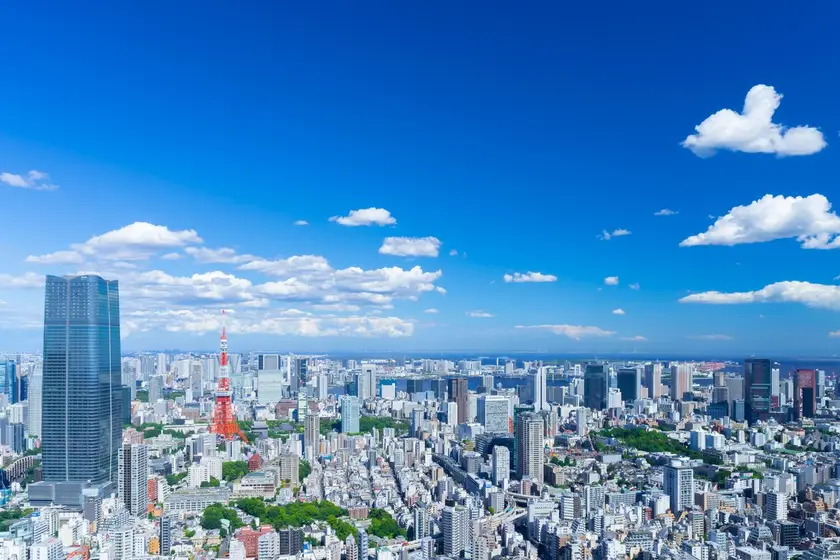
Roppongi is a vibrant district of Tokyo, known for its vibrant nightlife and cosmopolitan vibe . Located in Minato Ward, Roppongi attracts residents and visitors from all over the world seeking fun and entertainment. The area is dotted with skyscrapers, luxury boutiques, upscale restaurants, trendy bars and nightclubs. Roppongi is also known for its many cultural events, contemporary art exhibitions, and galleries that attract art lovers and artists. The Roppongi Hills complex , with its shopping malls, cinemas and observatory, is a must-visit destination for shopping enthusiasts and to enjoy beautiful panoramic views of the city.. The neighborhood also has a large expatriate community, with many foreign residents living and working there. This cultural diversity is reflected in the international restaurants, themed bars and multicultural events held regularly in the area. In summary, Roppongi is an eclectic neighborhood that offers a unique experience at any time of the day or night.
12. La Tokyo Skytree
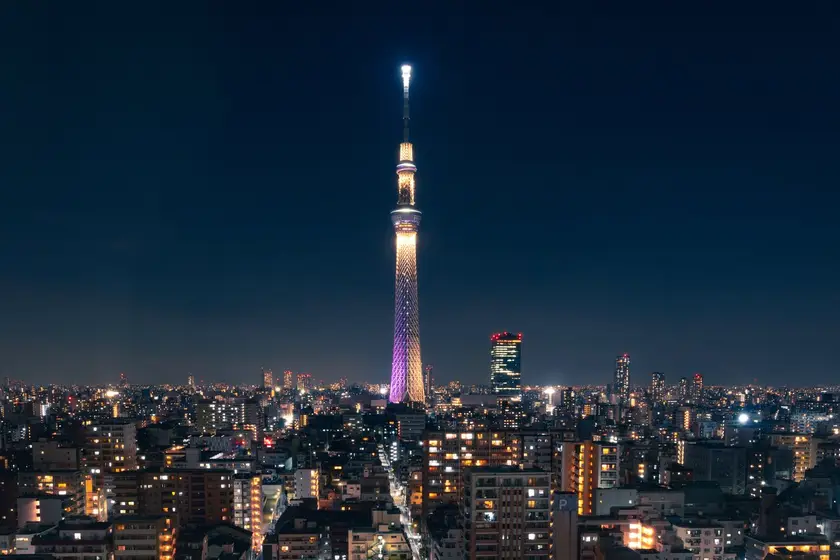
The Tokyo Skytree is an architectural icon of Tokyo, Japan, and one of the most iconic structures in the world . This broadcast tower, completed in 2012, is 634 meters tall, making it the second tallest freestanding tower in the world after the Burj Khalifa in Dubai. Located in the Sumida district, the Tokyo Skytree offers stunning panoramic views of the entire city and beyond, and has become a must-visit destination for touristsof the whole world. The tower houses two observation platforms, the highest of which, the "Tembo Deck" at 350 meters above sea level, offers a spectacular view of Tokyo, Mount Fuji on a clear day and the sea of clouds that sometimes envelops the city. Besides its aesthetic appearance, the Tokyo Skytree also plays a crucial role in broadcasting television and radio signals for the Tokyo region. Its design inspired by traditional Japanese architecture adds a unique cultural touch to Tokyo's urban skyline. Whether admiring the twinkling lights of Tokyo at night or enjoying the sunrise or sunset from its observatories, a visit to the Tokyo Skytree promises an unforgettable experience and breathtaking memories.!
13. Ginza
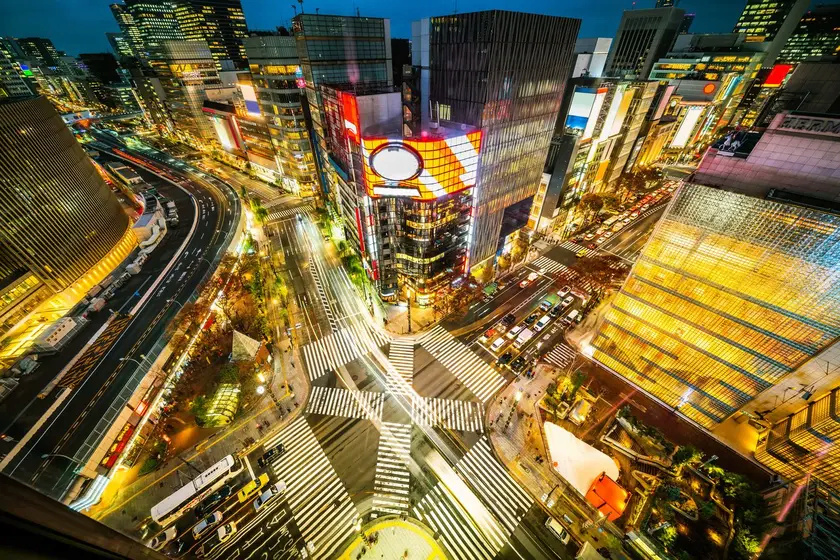
Ginza is an iconic district of Tokyo, renowned for being one of the most prestigious shopping destinations in the world. Located in Chuo Ward, Ginza is a showcase of luxury and sophistication. Its wide avenues are lined with luxury brand stores, designer boutiques, jewelry stores and historic department stores. Besides high-end shopping, Ginza also offers a fine dining experience with many Michelin- starred restaurants, cafes and cocktail bars. The neighborhood particularly shines at night, when its streets light up with twinkling neon lights, creating a breathtaking spectacle. On weekends, Chuo-dori Street becomes a pedestrian zone, providing visitors with a pleasant space to stroll and enjoy the lively atmosphere. Ginza is also the gathering place of artistic culture and architecture . The Kabuki-za theater, contemporary art galleries and innovative architectural buildings are an integral part of the Ginza experience.
14. The Ghibli Museum

The Ghibli Museum in Tokyo is a magical place dedicated to the world of Japanese animation created by Studio Ghibli, founded by legendary directors Hayao Miyazaki and Isao Takahata . Located in the Mitaka district, this museum is a true paradise for fans of the studio and films such as My Neighbor Totoro , Spirited Away and Howl's Moving Castle . The museum building, designed by Hayao Miyazaki himself, features whimsical architecture and looks like an enchanted house straight out of the movies. Interactive exhibits allow visitors to take a behind-the-scenes look at animation creation, as well as the techniques used by the studio. The Ghibli Museum also houses a cinema where exclusive and previously unreleased short films produced by the studio are screened. Additionally, its gardens are a peaceful place to stroll and soak up the poetic atmosphere of the Ghibli universe. Due to its popularity, it is recommended to book tickets in advance , as the number of visitors is limited each day. A visit to the Ghibli Museum is an unforgettable experience for fans of animation, art and the boundless imagination of Studio Ghibli's works.
15. Akihabara
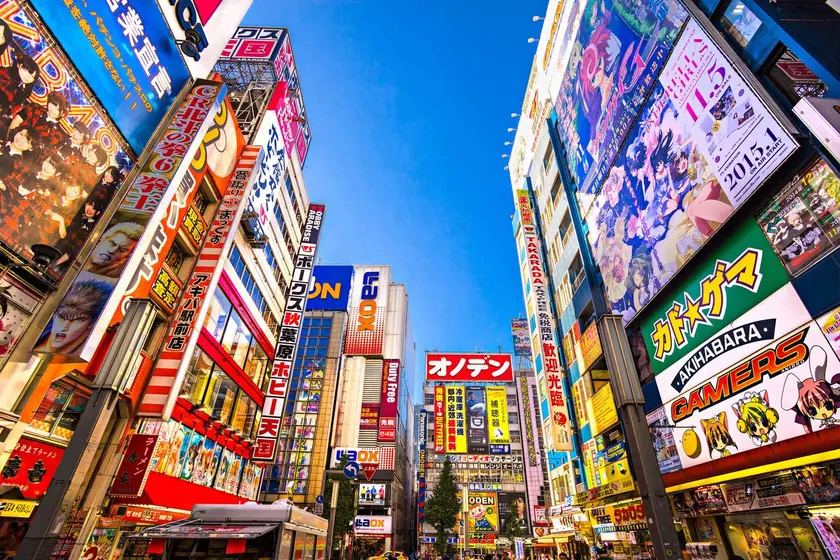
Akihabara, nicknamed "Electric Town", is an emblematic district of Tokyo, renowned for being a paradise for geeks and pop culture lovers. Located in Chiyoda Ward, Akihabara is the nerve center of electronics, video games, manga and anime in Japan. Its streets are lined with specialty stores offering a huge selection of electronics, high-tech gadgets, game consoles and accessories. Akihabara is also famous for its second-hand shops, where retro-gaming enthusiasts can find rare vintage consoles and games. Akihabara is also the meeting place for cosplay enthusiasts, who often gather for photo shoots and special events. Whether you are a fan of geek culture or simply curious to discover this unique universe, Akihabara is a captivating place that offers an immersive experience in modernity and Japanese subculture . Opt for oneHop-on hop-off bus ticket that will take you to discover Tokyo via Akihabara and many other must-sees!
!Are you interested in Tokyo? Discover our dedicated article
?Where to walk in Tokyo
Tokyo has many beautiful places to walk around and experience the city from different angles. Here are 5 pleasant places to walk in Tokyo:
- Yoyogi Park: This vast park is a great place to relax, jog or watch the street performers and groups of dancers who regularly gather there.
- Ueno Park: This historical park is one of the oldest in Tokyo and offers a great escape among the cherry blossoms in spring.
- The Sumida Canal: This walk along the canal offers a magnificent view of the Tokyo Skytree and allows you to enjoy a peaceful atmosphere in the heart of the city.
- The alleys of Yanaka: The Yanaka district is famous for its narrow streets and traditional wooden houses, offering a charming and picturesque atmosphere.
- The Imperial Palace Gardens: You can stroll around the Tokyo Imperial Palace and enjoy the magnificent landscaped gardens that surround it.
?What are the different districts of Tokyo
Tokyo is a huge and diverse city, with many unique and vibrant neighborhoods. Here are the 10 main districts of Tokyo:
- Shibuya: Famous for its lively pedestrian crossroads, it is a trendy district with fashion boutiques, restaurants, cafes, and a lively nightlife.
- Shinjuku: A cosmopolitan district with towering skyscrapers, department stores, cinemas, bars and entertainment venues.
- Ginza: Renowned for being the luxury and high-end shopping district, with major international brands, luxury department stores and fine restaurants.
- Asakusa: Known for the Senso-ji temple, it is a historic district with traditional shopping streets and an authentic atmosphere.
- Akihabara: Nicknamed "Electric Town", it is a paradise for geeks and pop culture lovers, with many electronics, video game, manga and anime stores.
- Ueno: A cultural district with many museums, Ueno Park and the Ueno Zoo.
- Roppongi: Renowned for its lively nightlife, contemporary art galleries and numerous bars and clubs.
- Harajuku: Famous for its eccentric fashions and designer boutiques, it is a popular neighborhood with young, trendy people.
- Odaiba: An artificial island with shopping malls, theme parks, beaches and panoramic views of the city.
- Ikebukuro: A lively district with department stores, shopping centers, restaurants and entertainment venues.
?Why move to Tokyo
Living in Tokyo offers a multitude of benefits and opportunities that attract many people from all over the world. Here are 5 reasons why many choose to settle in Tokyo:
- Career Opportunities: Tokyo is the economic center of Japan and offers many job opportunities in various sectors, including business, technology, design, English teaching, and more.
- Cultural and artistic life: Tokyo is a bustling metropolis with a vibrant cultural scene, festivals, art exhibitions, concerts and cultural events throughout the year.
- Varied cuisine: The gastronomy in Tokyo is a delight for the taste buds, with an abundance of restaurants offering traditional Japanese cuisine, as well as international dishes from all four corners of the globe.
- Efficient public transportation: Tokyo's public transportation system is among the best in the world, making it easy to get around the city and its surrounding areas.
- Safety: Tokyo is known for its safety and is considered one of the safest cities in the world.
Tempted by a vacation in Tokyo? Take advantage of a discount by booking your travel insurance here and leave with peace of mind! And to make it easier for you to organize your vacation, don't hesitate to discover the advantages of going through a local French-speaking travel agency.
Source: websites

